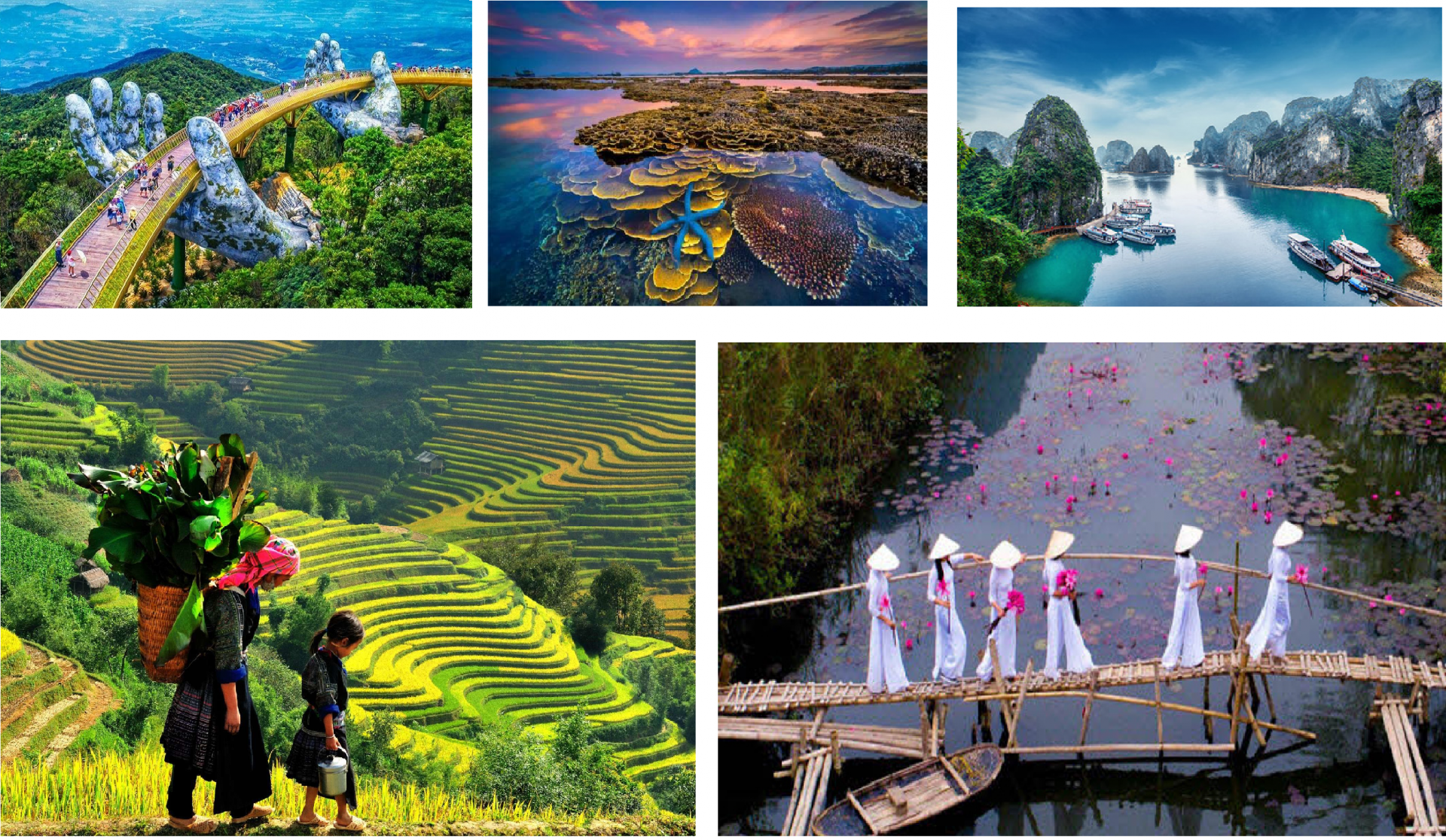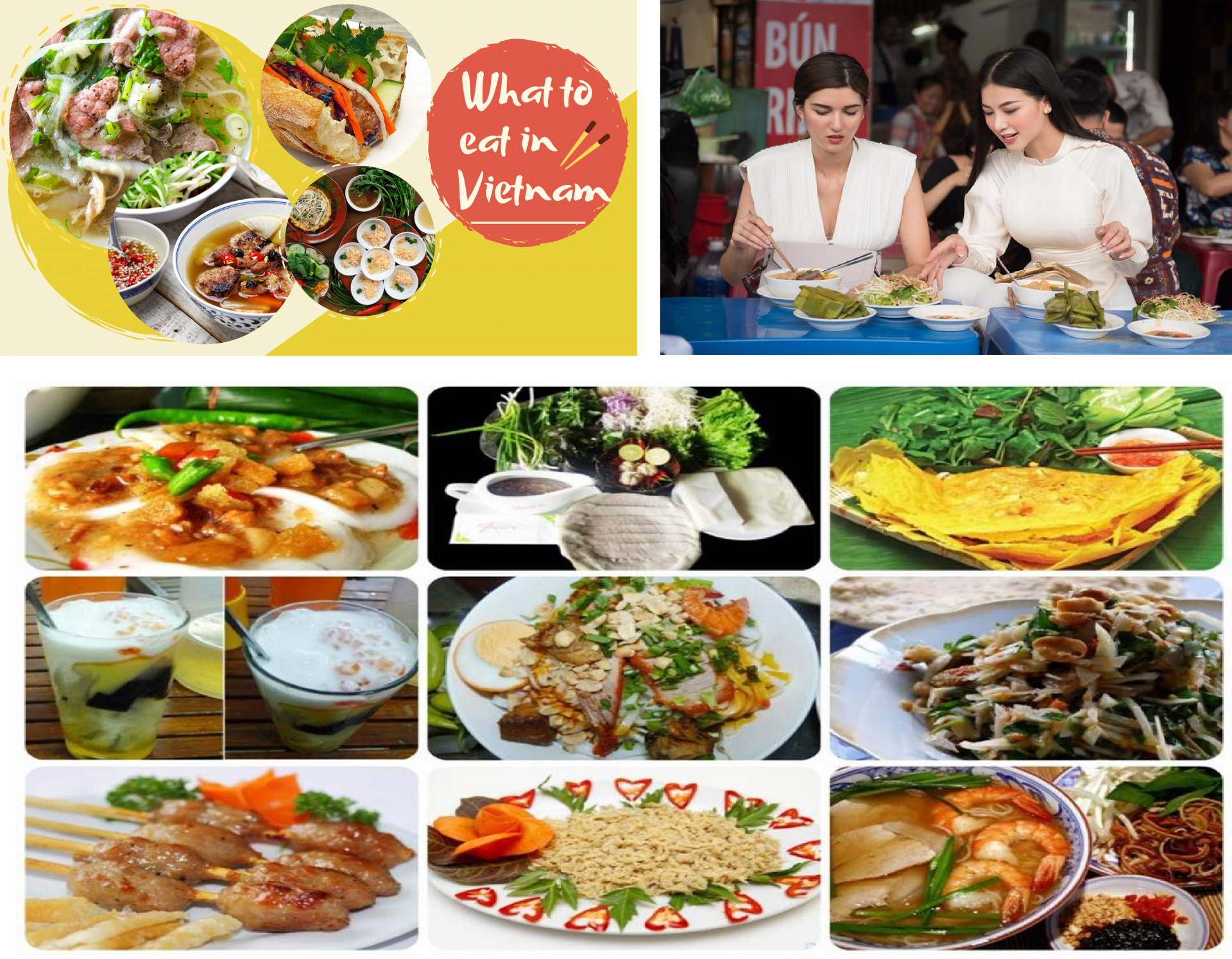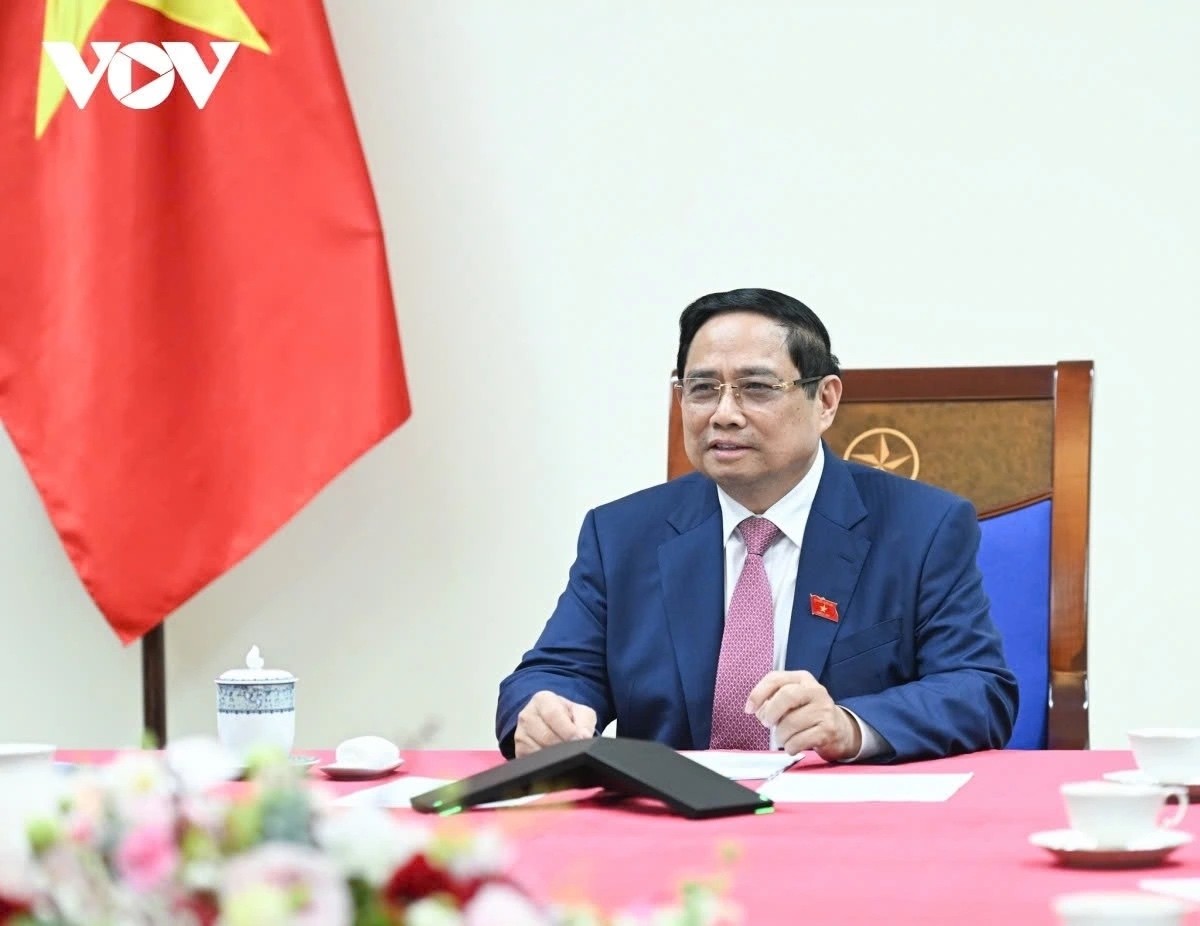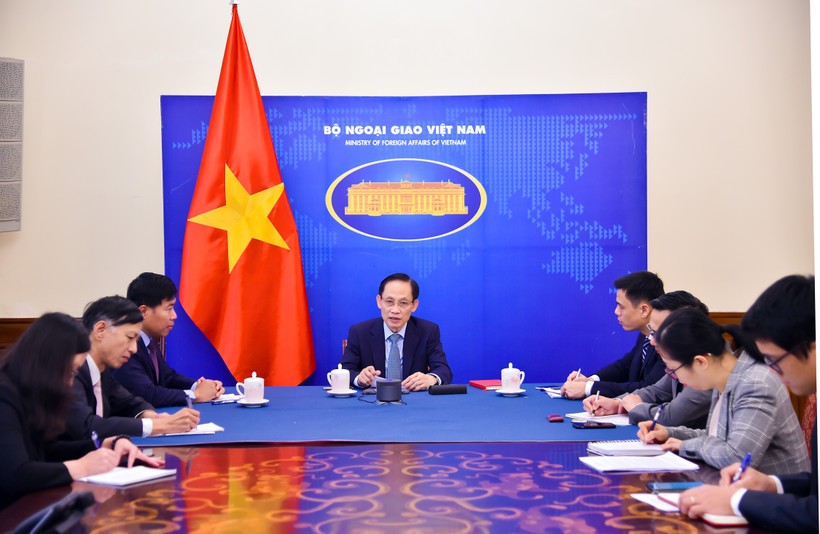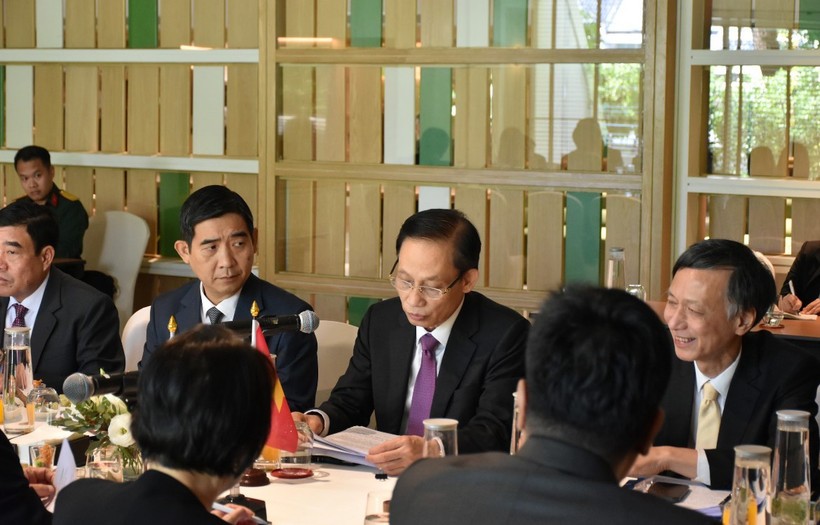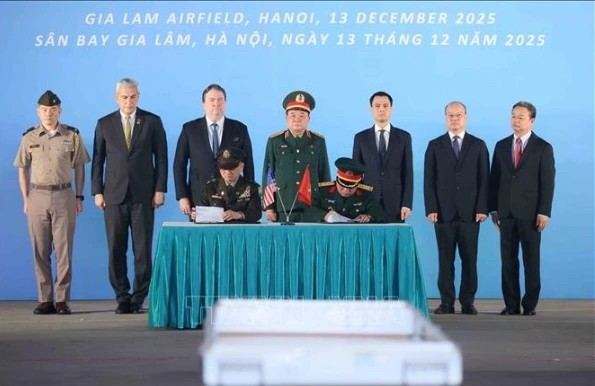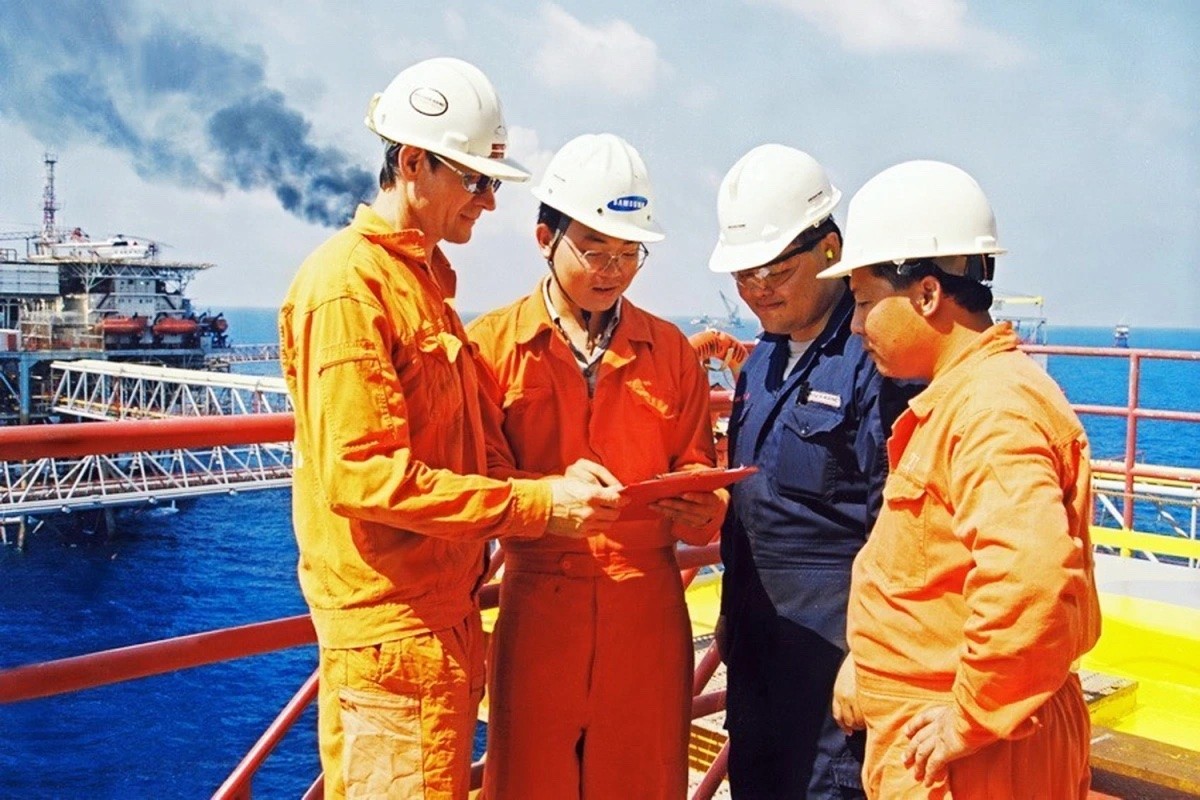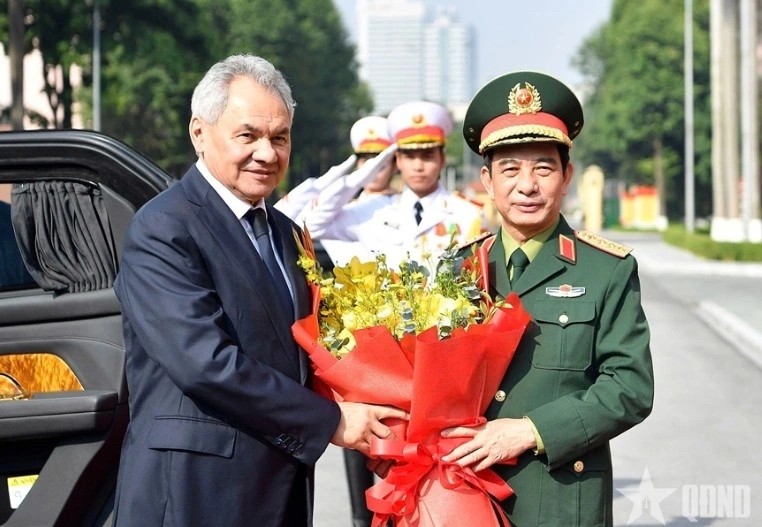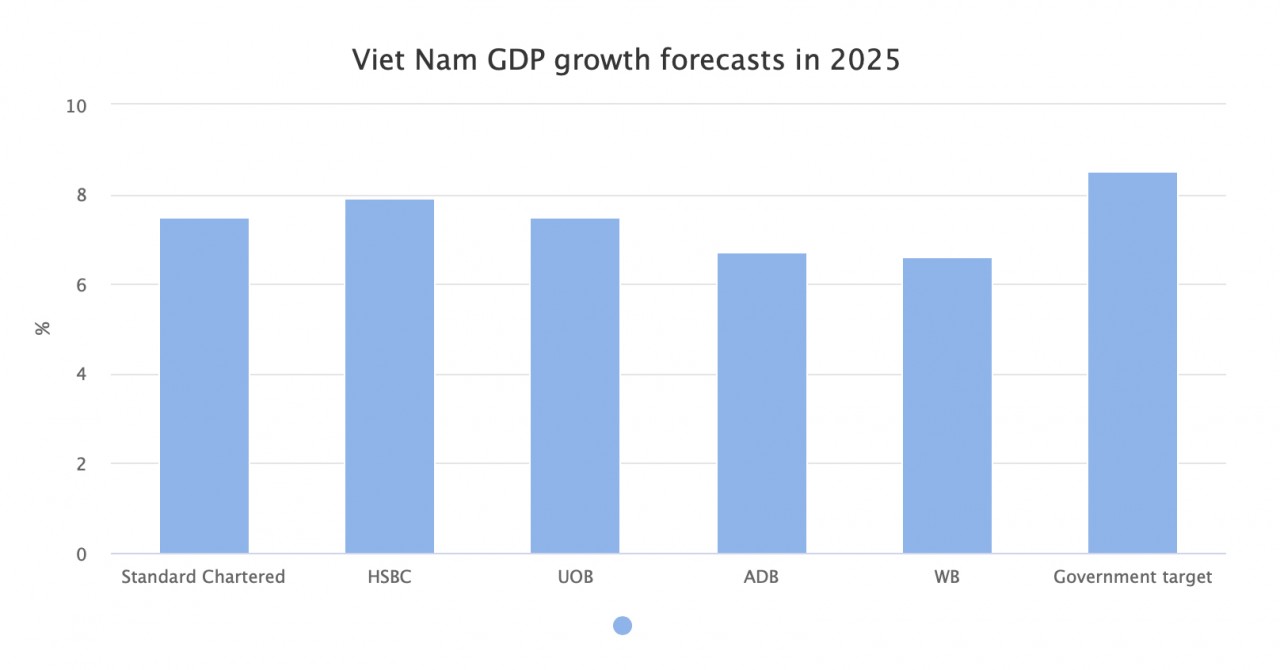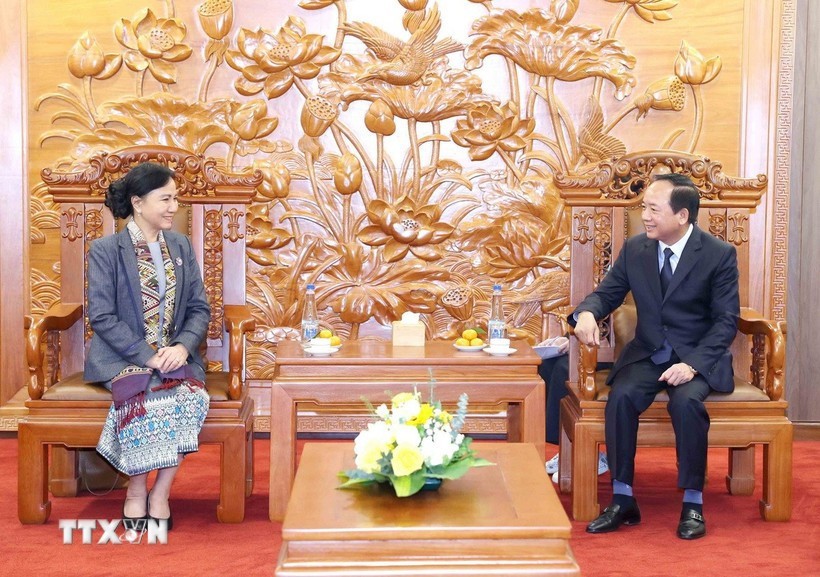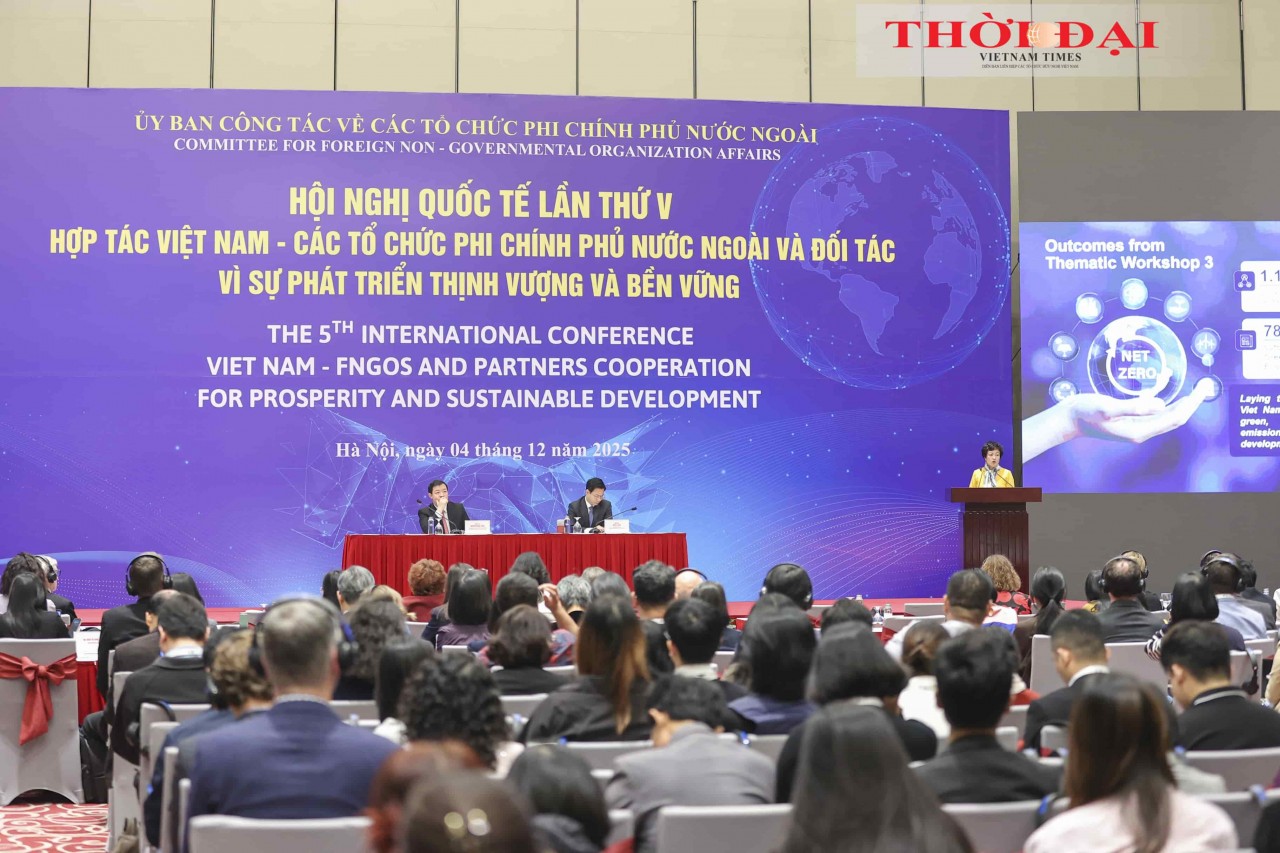| Vietnam News Today (Aug. 25) notable headlines Vietnam, Russia vow to continue boosting cooperation in economics, trade, education Visa policies - key to boosting tourism links with RoK, Taiwan 10% GDP growth: Vietnam’s bold target for 2030 Vietnam well-positioned to become hub for international education: scholar Kajiki response: Forward Steering Committee set up, mass evacuation gets underway |
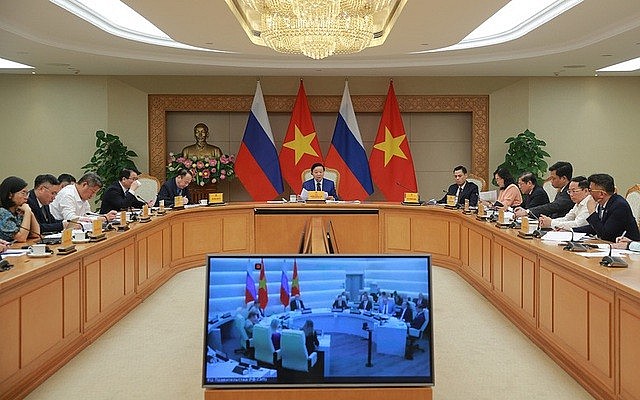 |
| Deputy Prime Minister Tran Hong holds virtual conversation with his Russian counterpart Dmitry Nikolayevich Chernyshenko, August 22, 2025. Photo: VGP |
Vietnam, Russia vow to continue boosting cooperation in economics, trade, education
Deputy Prime Minister Tran Hong Ha, head of the Vietnamese sub-committee of the Vietnam–Russia Intergovernmental Committee on Economic, Trade, and Scientific-Technical Cooperation, had a virtual conversation with his Russian counterpart Dmitry Nikolayevich Chernyshenko on Friday.
Chernyshenko extended his congratulations to the Party, State, and people of Vietnam on the occasion of the 80th anniversary of the August Revolution and National Day.
The relations between Vietnam and Russia have been strengthened via high-level visits and exchanges, he noted, adding that substantive cooperation have been promoted across spectra of economy, trade, investment, science and technology, culture, arts, and humanitarian affairs.
He urged both sides to continue implementing the cooperation development master plan till 2030, particularly in such areas as industry, agriculture, healthcare, and trade, cited VGP.
Tran, for his part, reiterated that there remains significant potential for bilateral cooperation in economy, trade and investment.
He welcomed Russia's initiative to establish a Russian school in Vietnam with a modern educational program, adding that the capital city of Ha Noi has allocated a site and stands ready to work with Moscow to implement the Moscow House project in the city.
He spoke highly of Russia's long-standing support in training high-quality human resources for Vietnam, which is currently focused on energy, digital transformation, science, technology, and arts.
The Vietnamese official also expressed the hope that Russia would continue to assist Vietnam in training experts capable of operating cooperation projects.
Tran called for the early organization of negotiations and working sessions at the government, ministerial, and sectoral levels to address urgent and important issues related to investment cooperation projects such as nuclear power and multidisciplinary technical centers, underlining the need to expand trade and investment between enterprises of the two countries.
The two Deputy Prime Ministers vowed to continue effectively carrying out cooperation agreements, thereby contributing to further deepening the comprehensive strategic partnership between the two nations.
Both sides pledged to join hands in addressing difficulties and promoting exports to each other's markets as well as to the Eurasian Economic Union, particularly in such sectors as agricultural products, food, textiles, and consumer goods.
They exchanged views on cooperation in oil and gas exploration, the development of products from liquefied natural gas (LNG), and LNG projects, while discussing ways to resolve obstacles in the implementation of the nuclear power plant project in the central province of Khanh Hoa.
Both officials affirmed their readiness to assign ministries and sectors to urgently prepare the agenda for the next session of the Vietnam–Russia Intergovernmental Committee on Economic, Trade, and Scientific-Technical Cooperation.
Visa policies - key to boosting tourism links with RoK, Taiwan
Visa facilitation was highlighted as a crucial factor in expanding tourism cooperation between Vietnam and two major markets – the Republic of Korea (RoK) and Taiwan (China) – during a seminar held in Ho Chi Minh City on August 23.
The event was jointly organized by the Ho Chi Minh City Tourism Association, Travel Association and Golf Tourism Association, and partners, aiming to strengthen two-way tourism exchanges and support Vietnamese businesses in tapping these important markets.
Nguyen Viet Anh, Vice Chairman of the HCM City Tourism Association, noted that the RoK and Taiwan have long been among Vietnam’s leading sources of international visitors. Arrivals from the two markets have grown steadily, while more Vietnamese are also traveling to these destinations, according to VNA.
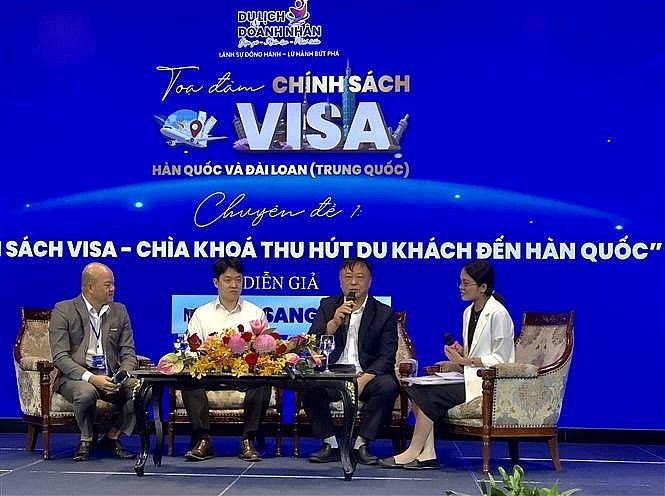 |
| Representatives of management agencies and tourism promotion units participate in the discussion at the seminar. (Photo: VNA) |
He said the seminar provides a timely channel for tourism enterprises to directly engage with officials from the RoK Consulate General and the Taipei Economic and Cultural Office in Ho Chi Minh City to receive updated information on visa regulations and procedures.
According to You Sang Byun from the Visa Section of the RoK Consulate General, visa policy plays a decisive role in attracting visitors. He stressed that the RoK has consistently sought to make it easier for Vietnamese travelers to obtain visas, helping businesses streamline processes and reduce errors.
Similarly, Derek Chou, Chief Representative of the Taiwan Tourism Bureau in Vietnam, underlined that Taiwan is committed to enhancing cooperation with Vietnam. He said updated visa policies would support joint efforts to promote tourism and encourage the development of new tourism products tailored to diverse customer needs.
Doan Ngoc Thao, Deputy General Director of The Swing Sports Tourism Joint Stock Company, pointed out that golf tourism is thriving, particularly among high-spending visitors from the RoK and Taiwan. Annual growth in this segment has averaged 10–15%, with strong rebounds following the COVID-19 pandemic.
She emphasised that Vietnam’s recent visa reforms including broader exemptions, extended stays and convenient e-visas have been a decisive factor in drawing more golfers, encouraging longer visits and repeat trips.
She added that golf tourism is not only a sport experience but also contributes to enhancing the image of the destination, promoting related services such as hotels, restaurants, and transportation. If Vietnam can maintain or expand favourable visa policies, the country will soon become the leading destination in Asia for golf tourists from the RoK and Taiwan.
10% GDP growth: Vietnam’s bold target for 2030
At the first Congress of the Party Committee of the Ministry of Finance, an ambitious target was set: average annual GDP growth of at least 10% and GDP per capita reaching USD 8,500 by 2030.
This is an unprecedented goal in Vietnam’s history. It reflects both national ambition and a test of reform capacity and governance.
From Doi Moi to a new global position
Nearly 40 years after the Doi Moi reforms, Vietnam has transformed from a centrally planned economy into a dynamic market-oriented system. By 2025, GDP is expected to reach USD 510 billion, ranking 32nd worldwide and 4th in ASEAN. In purchasing power parity terms, GDP is about USD 1.76 trillion, placing Vietnam 25th globally.
Per capita income has risen from USD 3,552 in 2020 to around USD 5,000 in 2025, with GNI per capita at USD 4,750 - officially surpassing the lower-middle-income threshold. Vietnam is now among the world’s 20 largest trading nations and a magnet for foreign direct investment (FDI).
Most importantly, poverty reduction has been a remarkable achievement: from 60% of households in 1986 to just 1.9% today. Each time constraints are lifted, Vietnamese enterprises and citizens demonstrate their ability to drive transformation.
The “double-digit” challenge
Over the past two decades, Vietnam’s average annual GDP growth has been around 6.4%, never reaching double digits. Setting a 10% target means moving beyond familiar pathways. Deputy Prime Minister Nguyen Chi Dung remarked: “Without new approaches and bold reforms, this goal will never be achieved.”
The Ministry of Finance’s report highlighted key challenges. First, the enormous need for investment capital. Achieving 10% growth requires simultaneous surges in public investment, private capital, and FDI. But excessive public spending could crowd out the private sector, while external borrowing faces interest rate and trade risks. Raising taxes could dampen consumption, VNN reported.
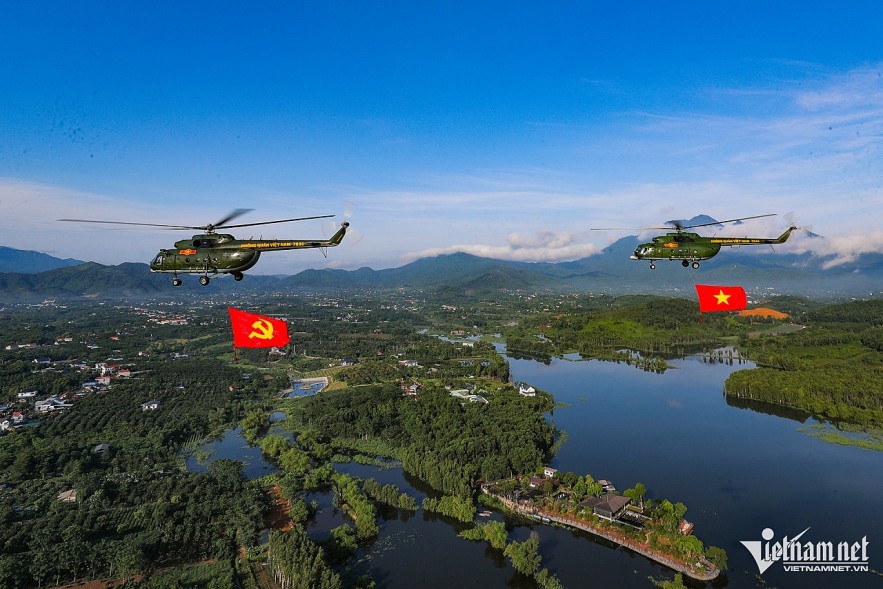 |
| During the 2026–2030 period, Vietnam is expected to attract 200–300 billion USD in registered FDI, disburse 150–200 billion USD, and increase the localization rate to over 40%. Photo: Vo Viet |
Second, productivity remains low. To sustain 10% growth, total factor productivity (TFP) must contribute 50.3% to growth and rise 5.2% annually - much higher than past levels. If TFP only grows at the historical 3%, GDP could fall short by 3–5 percentage points.
Third, domestic consumption is weak. Household spending is insufficient to drive growth, and government consumption cannot compensate.
Inflation is another risk. With an average fiscal deficit of 5% of GDP and rising public expenditure, inflation could exceed the 4–4.5% target. Power supply is also critical: 10% GDP growth means electricity demand rising 1.4–1.6 times faster than GDP. Without a robust energy strategy, growth will stall.
Finally, Vietnam’s industry remains shallow, with low localization, weak links between FDI and local firms, and underdeveloped sectors such as machinery, new materials, and defense industries.
Institutional bottlenecks and domestic capacity
The main obstacle lies not in capital, but in institutions. While the non-state economy accounts for over 50% of GDP, formally registered enterprises represent less than 10%. The economy still relies heavily on small family businesses, street vendors, and craft villages.
The 2030 target envisions 2 million operating enterprises, private sector growth of 10–12% per year, at least 20 firms in global value chains, 50 state-owned enterprises among Southeast Asia’s top 500, and one Vietnamese company in the global top 500.
But how can this be achieved when a single real estate project requires 40 different approvals, and business regulations still number nearly 16,000?
How can 2,887 stalled projects - worth USD 235 billion and covering 347,000 hectares - be unlocked for development?
Without institutional reform, the private sector cannot grow strong enough, leaving the economy dependent on cheap labor and outsourcing.
From 2026 to 2030, Vietnam aims to attract USD 200–300 billion in registered FDI and realize USD 150–200 billion, while raising localization above 40%. This is ambitious, but more importantly, FDI must become a catalyst for domestic enterprises.
If Vietnam wants to see its companies in the global top 500, it must cultivate strong domestic corporations, not rely solely on foreign investors.
The only path: Relying on people and businesses
Ho Chi Minh once said: “Whatever benefits the people must be done with all our might, whatever harms the people must be avoided.” Today, relying on the people means freeing businesses and unlocking society’s potential.
Institutional reforms must eliminate red tape, simplify business conditions, ensure land and credit transparency, and guarantee fair competition. Private enterprises must become the backbone of growth.
To reach 10%, Vietnam needs a powerful private sector driving green transition, circular economy, semiconductors, AI, renewable energy, and advanced materials - sectors that create high added value.
Property rights and contract enforcement must be strengthened. Entrepreneurs should not face travel restrictions for tax arrears. Many other obstacles must be cleared.
Alongside this, Vietnam needs a long-term energy strategy: expanding renewable power, building transmission infrastructure, and ensuring energy security ahead of demand.
Macroeconomic stability is also essential, with inflation around 4–4.5%, fiscal deficit at 5% of GDP, and public debt at 45% - a difficult but non-negotiable balance.
Destination 2030
Reaching USD 8,500 GDP per capita by 2030 means doubling income within five years - a feat with no precedent in Vietnam.
According to the World Bank, of more than 100 middle-income countries since the 1960s, only 13 have escaped the “middle-income trap.” The path is narrow, but not impossible.
The prerequisite is bold institutional reform, higher productivity, and unleashing the full potential of businesses and citizens.
Marking 80 years of nationhood, Vietnam faces a vital question: How will it pursue 10% growth?
If reforms are decisive, Vietnam has a chance to join the small group of countries that achieve high-income status.
Ten percent growth is both a dream and a test for today’s generation. The answer lies in removing constraints and empowering people and businesses - to continue the 80-year journey with a future worthy of the nation.
Vietnam well-positioned to become hub for international education: scholar
Resolution No. 59-NQ/TW of the Politburo on international integration in the new context is a breakthrough policy that opens up sustainable development opportunities for Vietnam, said Professor Vu Minh Khuong from the Lee Kuan Yew School of Public Policy.
Speaking to the Vietnam News Agency in Singapore, Professor Khuong noted that beyond integration in economy, science, technology, and innovation, Vietnam should also advance integration in education.
He underlined that global integration today is about attracting talent, and Vietnam has strong potential to emerge as a hub of international education. With experience and capacity of more than 100 million people, the country should aim to attract between 400,000 and 500,000 foreign students.
Elevating Vietnamese universities to at least regional level in Southeast Asia, he added, will give greater boost to the country’s integration efforts. While Vietnam has so far concentrated on goods, exports, and investment, stronger focus on education and high-value services such as advanced professions, digital technology, and artificial intelligence could help it achieve deeper and broader integration, cited VNA.
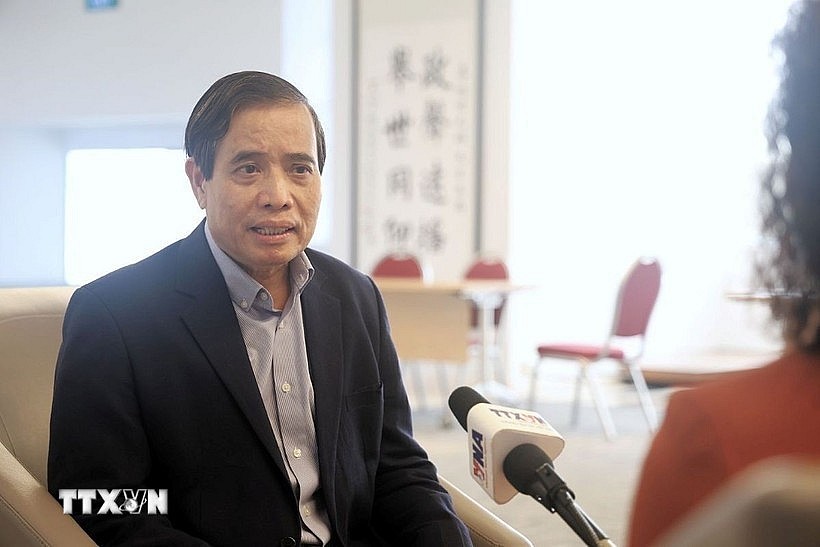 |
| Professor Vu Minh Khuong speaks in an interview with Vietnam News Agency reporters. (Photo: VNA) |
On challenges ahead, the professor pointed to cybersecurity, supply chain disruptions, and energy security as major risks. Vietnam, he said, must anticipate these challenges and develop effective responses, not only to protect the nation and its economy but also to set an example for the international community, thereby further strengthening its global standing.
Kajiki response: Forward Steering Committee set up, mass evacuation gets underway
Vietnam has decided to set up a Forward Steering Committee and conduct a mass evacuation of residents before Typhoon Kajiki makes landfall at noon August 25.
The Forward Steering Committee, led by Deputy Prime Minister Tran Hong Ha, is located in central Nghe An province to oversee and direct typhoon preparedness and response efforts.
The Standing Office of the National Civil Defence Steering Committee was required to coordinate with Military Region IV and relevant ministries and agencies to ensure logistical support, provision of equipment and vehicles, and communication systems for the Forward Steering Committee’s operations in all situations.
As of 4:00 p.m. on August 24, Kajiki was moving fast toward the central coast of Vietnam, packing winds of 134 – 166kph, with gusts up to more than 200kph. According to the National Center for Hydro-Meteorological Forecasting, the typhoon will continue to encounter highly favourable conditions for further strengthening in the evening.
Over the next 12–24 hours, the typhoon is anticipated to move mainly west-northwest at about 20 kmh. Around midday and afternoon of August 25, it is likely to make landfall across central coastal provinces from Thanh Hoa to Quang Binh, with the center of the typhoon near Nghe An and Ha Tinh provinces.
Due to the impact of the typhoon, from August 24 to 28, flooding is expected in provinces from Thanh Hoa to Thua Thien Hue. Authorities warned of a high risk of flashfloods, landslides, and rockfalls in the midland and lowland areas of Northern and Central Vietnam, especially from Thanh Hoa to Hue.
There is also a high risk of inundation in low-lying coastal areas and river mouths due to rising water levels and large waves on the afternoon and evening of August 25.
Hoang Phuc Lam, deputy director of the National Center for Hydro-Meteorological Forecasting, reminded that the intensity of the typhoon when it hits Vietnam on August 25 could be comparable to Typhoon Yagi in 2024 and stronger than Typhoon Doksuri in 2017. Both Yagi and Doksuri caused extremely severe damage to Vietnam, according to VOV.
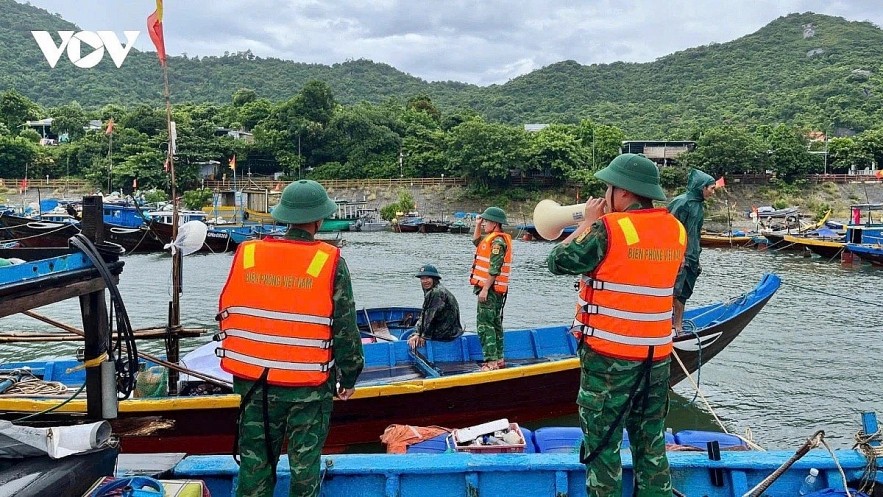 |
| Border Guards use loudspeakers to instruct boats and ships to return to shore and seek safe anchorage in Hue city. |
For this reason, the National Center for Hydro-Meteorological Forecasting has raised the natural disaster risk warning to level 4 out of a total of 5 levels. Local authorities and people were urged to act swiftly and decisively, evacuate when instructed, and avoid complacency.
Local authorities are racing against time to evacuate residents to safe locations. As of the afternoon of August 24, provinces and cities of Thanh Hoa, Nghe An, Ha Tinh, Quang Tri, Hue and Da Nang moved more than 675,000 residents from areas vulnerable to flooding, flashfloods and landslides to safe locations.
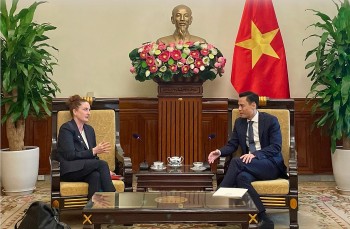 | Vietnam News Today (Aug. 21): Vietnam and New Zealand Promote Comprehensive Strategic Partnership Vietnam News Today (Aug. 21): Vietnam and New Zealand promote Comprehensive Strategic Partnership; Vietnamese, Uruguayan foreign ministries hold 5th political consultation; Vietnam is dynamic economy: ... |
 | Vietnam News Today (Aug. 22): Vietnam Prioritizes Comprehensive Preparations for APEC 2027 Vietnam News Today (Aug. 22): Vietnam prioritizes comprehensive preparations for APEC 2027: Deputy PM; Vietnamese, Chinese legislative bodies enhance collaboration; UN Deputy Secretary-General hails proud ... |









